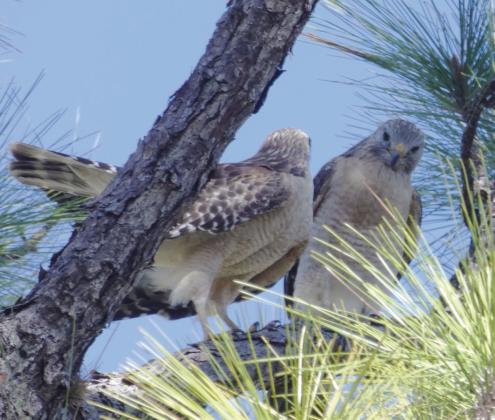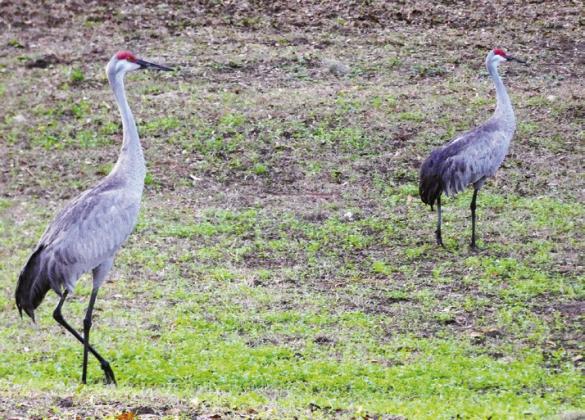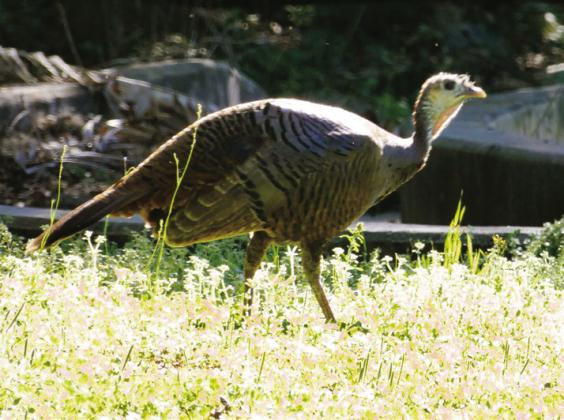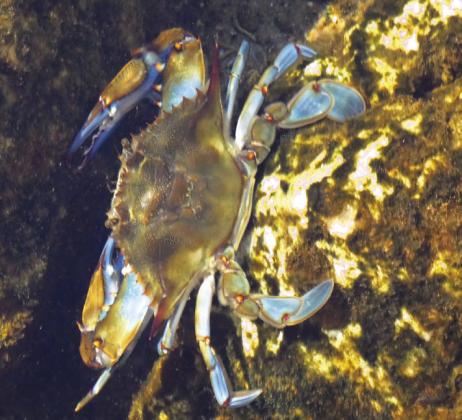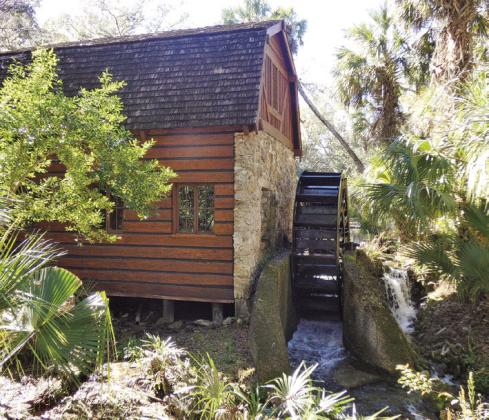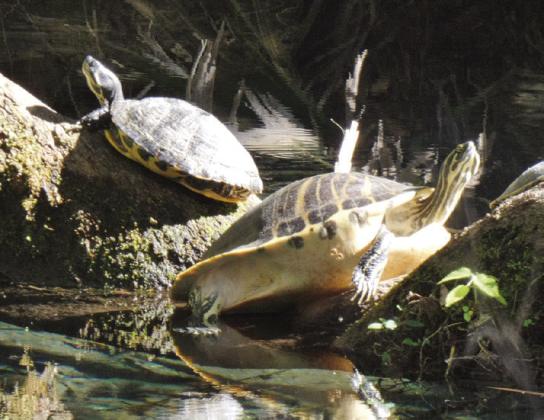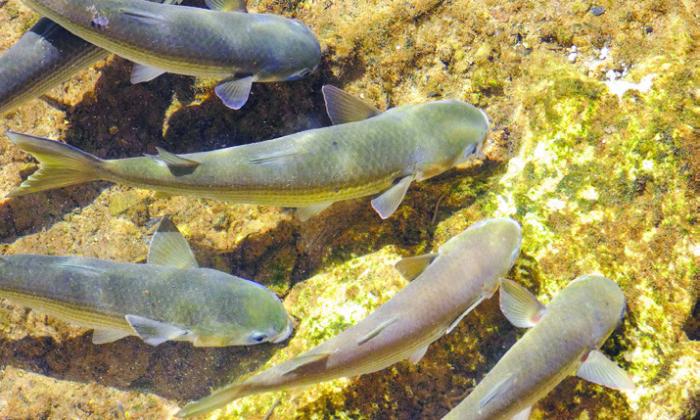by LeMoyne Mercer
“WELL,”I SAID TO SHIRLEY, “I guess 187 pictures of turtles is probably enough for today.” It was March and Florida was attracting the usual influx of spring breakers. Even the turtles were acting frisky. Or as frisky as possible for turtles. Several males were in pursuit of considerably larger females.
We were at Salt Springs in Ocala National Forest and had been rotating through Juniper Springs and Alexander Springs as well. Each has its own considerably different attractions in addition to frolicking turtles. All the 1,000 or so springs in Florida have absolutely clear water bubbling up at a year-round temperature of 72°. The water usually feels warmer than the air temperature in winter and cooler in summer so the springs are popular all year. Springs form where surface water has percolated down through layers of porous limestone. The weight of new rain water creates pressure on the existing ground water, pushing it through cracks and crevices until it finds an exit. Thirty-three of these springs are classified as first magnitude; that is, they flow at the rate of at least 100 cubic feet per second or about 65 million gallons a day.
For RVers, the main attraction at Salt Springs is full hookups—water, electricity, and sewer. This is rare at national forest campgrounds. And the campground is manicured; that is, there is no undergrowth beneath the canopy of longleaf pines and live oaks trailing Spanish moss. The grass is trimmed and leaf blowers used daily so it has the feel of a city park right down to the squirrels that have learned to beg or steal from campers.
Some wildlife, though, is a little more exotic. While we were having breakfast, we heard some familiar and easily recognizable squawking as a pair of sandhill cranes landed right behind our rig. This attracted the notice of several dogs that immediately alerted their owners. Some campers shared the dogs’ excitement. Others were veterans and paid no more attention than they did to the squirrels. For their part, the cranes were not perturbed by either dogs or people. They are big enough to take care of the themselves. In a similar vein, there were wild turkeys quite confident that they were in a sanctuary where hunters were not allowed to disturb them.
The 130 ft. by 190 ft. walled-in spring pool empties into Lake George and from there to the St. Johns River. Most of the pool is only about waist deep with a sandy bottom except at the rocky vents, or “boils,” from which the water bubbles up at the rate of 50 million gallons a day. It is easy wading for adults and popular with small children who feel confident with the help of various flotation devices. The current from those vents gently pushes swimmers away from the narrow openings. This is an attraction in itself because it gives everybody a free, gentle ride. Parents need not worry about children going exploring in there. The boils also attract surprising numbers of mullet and blue crabs for the entertainment of snorklers of all ages. The salt, by the way, is mostly magnesium, potassium, and sodium in concentrations that are barely detectable unless you are a chemist.
The mouth of the spring pool is cordoned off by a line of buoys, not so much to keep swimmers in as to keep boaters out. Swimmers venture beyond the buoys on quiet days to cavort with docile manatee cows and calves. Weekends, especially MLK Day and Presidents Day, do not count as quiet days. Nor does the second half of March when spring breakers arrive en masse. An extensive picnic area in the shade of live oaks attracts groups as well as families. Early mornings, though, tend to feature just a couple geezers gently paddling around for awhile and then sitting in the sunshine.
About 20 miles south is Juniper Springs where the experience is similar but different. The similarity is a concrete retaining wall and sidewalks, built by the Civilian Conservation Corps in the 1930s, that enclose the entire swimming area except for a functions. The mill wheel turns but is not attached to a turbine’s generator. Last winter, contractors rebuilt the cedar shingle roof and re-stained the exterior log walls. This year, they refinished the floors, replacing some of the wide, century-old oak planks with the narrower, tongue-and-groove kind available today. The millhouse is picturesque but, because of modern building materials, is no longer what you would consider authentic.
The pool at Juniper Springs is smaller in circumference than Salt Springs but considerably deeper. Entering via the steps, the white sand bottom appears only about four, maybe five feet deep. But we were deceived by the exceptional clarity of the water. When Shirley stepped off, she didn’t touch bottom. But she’s only five feet tall. I’m six feet. Didn’t touch either. Turns out that the pool is 16 feet deep.
At the mill end of the pond are three limestone caves from which the water emerges. Three teenagers noticed that someone had dropped their keys into the mouth of one cave. They tried several times to retrieve them but were pushed back by the current. Also at the mill end is a bed of aquatic grasses that serves as a refuge for turtles and eels when people are thrashing about. Little guppies don’t mind all that thrashing about. They hang out all along the edge of the pool to nibble the toes of people who dangle their legs over the edge. It tickles. A good time is had by all.
Shirley and I spent a total of four weeks at Juniper Springs between the end of January and the middle of March, alternating with Salt and Alexander Springs. Our daily routine was to visit the main pool and then take the Blue Trail for 15 minutes to Fern Hammock, an undeveloped spring, for a totally different experience. Visitors are warned that it is alligator habitat and entering the water is both dangerous and will result in being expelled from the park. This seems like a sensible rule. Frankly, though we have been there numerous times, we have never seen a gator.
The setting itself is simply stunning. Spring water pulses up rhythmically through bright white sand at the rate of only about 10 cubic feet per second—about a tenth the rate of first magnitude springs. There is a mystical sapphire-blue glow as the sky is reflected off the water and white sand bottom. The small pond formed at the Hammock is surrounded by palmettos, magnolias, and live oaks with their ubiquitous Spanish moss. The oaks growing at the edge of the water send out horizontal branches, some of which curve down right to water level. Angling gently up from the water and mirrored in it, they are favorite sunning places for turtles.
The resident snapping turtle is recognizable by the shape of his much larger head and a much more prominent tail. When not out feeding, he spends his time tucked away beneath an undercut bank. A river otter was an occasional visitor who arrived via the stream that drains the pool and, after thrashing about in the pursuit of fish, he leaves the same way. Timing is everything. Most visitors will see neither the otter nor the snapping turtle. But they will probably see, or at least hear, the pileated woodpecker drumming in the oaks. Likewise, the Hammock is a place to hear the screescree calls of hawks circling overhead. It is also where we watched some striped bass preparing spawning beds by sweeping indentations in the sandy bottom with their tails. Males were contending for the right to fertilize the eggs.
We visited Alexander Springs for the first time in 2009 and have made it part of every trip to Florida since.
The setting is much more natural and rustic. There is a narrow band of sandy beach with about 75 feet of retaining wall and steps into the water, but, other than the picnic grounds, there are few “improvements.” The other side of the 300-foot-wide pool is lined by spadderdock (yellow water lilies) and then dense, semi-tropical forest.
In addition to families, the swimmers at Alexander Springs include a steady stream of snorklers and, on weekdays, people taking scuba lessons. Every week also includes Mermaid Monday, on which the maids in colorful costumes come to practice. It takes skill to swim with your ankles bound together in a tail. One day, there was a pair of professional photographers taking underwater pictures of an attractive young woman.
Unlike Fern Hammock, Alexander Springs does have resident alligators. A woman in the camp store said not to worry. If you leave something in their tip jar, they won’t bother you. Even so, the staff enforces the 5:30 closing time at the pool because the gators tend to gather in numbers as sunset approaches.
Sometimes earlier. One morning, we were watching a class of scuba divers preparing to descend about 30 or 40 feet to the caves from which water boils up. A six-foot gator cruised in, paying no apparent attention to the divers. But they paid attention to him and promptly abandoned the dive.
Canoes and kayaks are available for rent, and many visitors bring their own as well. There is a launch area just outside the buoy line. Within a quarter mile or so, Alexander Spring Run makes a bend to the right and passes through dense forest on either side as it flows eight miles to the St. Johns River. Away from the crowds at the pool, there is a much better chance to see herons and egrets or a little pied billed grebe hunting for fish in the shallows.
The more natural environment is why Shirley and I prefer Alexander Springs. “Natural” includes the campground itself where our favorites sites are secluded among the trees and low-growing palmettos that create privacy screens. As at other places we visit, we keep campground map files with desirable sites circled to indicate those that are level, shady or sunny depending on the season, and within reasonable proximity to restrooms.
A particular reason for scheduling Alexander Springs is also its proximity to the Winter Horse Trials at Rocking Horse Stable, just 15 minutes away at Umatilla. But that is a story for another month. Meanwhile, if you are curious and just can’t wait another month, get a preview at my blog “Horsing Around” posted on Oct. 4, 2018 in AnotherWalkinthePark.blogspot.com.
If you are contemplating a trip, you might want to see pictures and information on numerous destinations at AnotherWalkInThePark. blogspot.com. ✲

